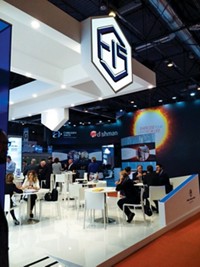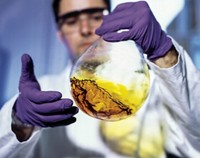Advertisement
Grab your lab coat. Let's get started
Welcome!
Welcome!
Create an account below to get 6 C&EN articles per month, receive newsletters and more - all free.
It seems this is your first time logging in online. Please enter the following information to continue.
As an ACS member you automatically get access to this site. All we need is few more details to create your reading experience.
Not you? Sign in with a different account.
Not you? Sign in with a different account.
ERROR 1
ERROR 1
ERROR 2
ERROR 2
ERROR 2
ERROR 2
ERROR 2
Password and Confirm password must match.
If you have an ACS member number, please enter it here so we can link this account to your membership. (optional)
ERROR 2
ACS values your privacy. By submitting your information, you are gaining access to C&EN and subscribing to our weekly newsletter. We use the information you provide to make your reading experience better, and we will never sell your data to third party members.
Business
Higher Technology
The rebounding custom pharmaceutical chemical business pushes the high-tech envelope
by Rick Mullin
September 24, 2007
| A version of this story appeared in
Volume 85, Issue 39

When the fine chemicals industry converges on Milan early next month for CPhI, the conference on pharmaceutical ingredients, it will have had a solid year of recovery under its belt. It will also look slightly different than it did going into the slump that began in 2000. Among other things, it will be slightly more high-tech.
Process technologies such as simulated moving-bed (SMB) chromatography, supercritical fluid chemistry, and microreactors, although not entirely new to the pharmaceutical industry, are gaining acceptance, and custom manufacturers are adding them to their tool chests. Some companies are introducing commercial-scale versions of what had only been offered at lab scale.
One thing that is not likely to have changed at this year's CPhI is concern among Western suppliers about competition from Asia, particularly from Indian companies. Little takes place in fine chemicals outside the context of global competition. In fact, several firms acknowledge that their high-tech specialization moves are calculated to give them a leg up on low-cost Asian suppliers.
"The pharmaceutical industry is beginning to invest in technologies that have been out there for 10 to 20 years," says James Bruno, director of consulting firm Chemical & Pharmaceutical Solutions.
He notes, for example, that Cephalon and its pharmaceutical chemical suppliers began using SMB technology in 2004 to manufacture R-modafinil, the chiral active ingredient in the narcolepsy treatment Nuvigil. Similar moves are being made with the use of supercritical fluids and microreactors as drug firms bring to market highly active, complex compounds or revamp production of existing drugs to reduce costs. Bruno sees a wave of investment on the part of custom manufacturers in response. "This industry mimics the pharmaceutical industry," he says.
Most custom manufacturers are loath to make big investments until they detect likely growth in demand for a technology, if not hard contracts. But today, many tell C&EN, they see a green light on investment in new technologies or on expansion of pilot high-tech production projects to larger scale.
Lonza, perhaps the largest custom pharmaceutical manufacturer, has identified drug-antibody conjugates as a new opportunity that has synergies with its three-year-old business in highly active pharmaceutical ingredients (HAPIs), according to Walter Brieden, head of R&D for the company's exclusive synthesis division. Lonza is planning to open a $55 million HAPI facility in Visp, Switzerland, next year, and the firm is investing $42 million in conjugates, which it began manufacturing in 50- to 100-g quantities this year. The current investment will increase capacity to 150 g, Brieden says.
Conjugates, which are gaining attention in oncology, link a cytotoxic compound or peptide to a monoclonal antibody that delivers the drug directly to the cancer cell. The conjugate remains inactive in the body until it reaches the cell.
Brieden says his company is already talking to clients about the custom manufacturing of conjugates. "Most of the investment we do at Lonza is connected to real business opportunities," he says. "We are working on projects we intend to put into the new building."
According to John F. McGarrity, Lonza's director of R&D outsourcing, technology development at the firm also encompasses efficiency and lowering the cost of operations. The company has begun employing membrane technology to improve solvent recovery, for example. It has also been moving into continuous process manufacturing in its exclusive synthesis operation.
"Our organic chemicals division has been doing large-volume continuous processing for a long time," McGarrity says. "In fine chemicals, it is an area we entered three years ago and are pursuing with an emphasis on microreactors."
Lonza is currently producing kilogram quantities of material with microreactors. "We can use this technology for faster, more efficient process development activities," Brieden says. "Microreactors can be used to screen certain conditions in a much shorter time frame than it would usually take using batch reactors."
Lonza is also venturing into SMB chromatography, a technology that has been employed for more than a decade in drug manufacturing but primarily on a small scale. According to Brieden, the company is working on a pilot-scale project with a client and has no current plans to install a large-scale SMB plant.
SMB, however, is an area of specialization for firms such as Novasep, which markets both SMB systems and manufacturing services, and Ampac Fine Chemicals, formerly Aerojet. Both companies claim the technology is gaining momentum at commercial scale.
"Several APIs are already produced using SMB, some at hundreds of tons per year," says Jean Bl??haut, president of Novasep's pharma business unit. "The facts are published, but there is still a large portion of the pharmaceutical industry that is unaware of this or unwilling to consider the technology."
Novasep hopes to manage customers' transitions into large-scale production by succeeding at the small scale and asking them to keep their options open, according to Bléhaut.

"We tell the industry that with chromatography, it is very easy to scale up from gram scale to ton scale," he says. "As you scale up production of an enantiomer, you can also develop an asymmetric approach that you can file with the Food & Drug Administration in case it ends up being more economical. Our strategy is to try to educate the industry to evaluate chromatography systematically at an early stage for clinical trials. If it works, then you know you have the technology to produce at ton scale."
Novasep also has a background in supercritical fluid chromatography, a separation technique that employs compressed carbon dioxide in place of organic solvents. It, too, is advancing in drug manufacture primarily to speed up analysis time and prepare small quantities of material for drug discovery, Bléhaut says. "It is widely used at analytical scale and is probably more than an emerging technology at this point," he adds.
Early next year, Novasep plans to introduce supercritical fluid technology in a multicolumn chromatographic process. "We will reproduce what we did to put SMB in place of traditional high-pressure liquid chromatography technology," he says, noting that the company and a client have put supercritical fluids into a commercial-scale 20-cm-diameter separation column to produce an API.
Olivier Dapremont, manager of SMB operations at Ampac, says FDA's Process Analytical Technology Initiative, which facilitates the use of continuous processing by allowing on-line quality monitoring, is behind the drug industry's increased use of SMB and other advanced technologies. Continuous processing is a central thrust at Ampac, which in addition to SMB offers highly energetic reactions using sodium azide and isomethane and high-containment synthesis of cytotoxic and highly potent APIs.
According to Dapremont, Ampac is systematically converting its production capacity to cascading reactors, which can be adjusted to facilitate continuous processing. "We are looking in the next few years to set up a kilo lab for continuous processing," he says. "Right now we have R&D lab scale. We are looking at 20- to 50-gal reactors."
Ampac wants to hone an edge of specialization. "We understand that we cannot compete for everything," Dapremont says. "Providing unique technology is one way to differentiate ourselves."
Potential competitors are making tentative moves. Saltigo, for example, has operated a pilot-scale SMB plant for several years and recently developed an SMB process for a drug intermediate, although the client later dropped the project. The technology had proved feasible in late-stage development, according to Wilhelm Stahl, head of pharma at Saltigo.
Saltigo also inherited microreactor capacity from Bayer, which spun off the firm as part of Lanxess three years ago. These assets, and staff familiar with the technology, are poised on deck, Stahl says. "We are still waiting for the first interesting project to come along," he says, noting that although microreactor technology can offer advantages, Saltigo has been able to develop efficient batch solutions instead. "Historically, chemists want to solve problems by getting the chemistry right," Stahl says.
At SAFC, the fine chemicals division of Sigma-Aldrich, new technology, such as solid-state chemistry expertise, is viewed as an important supplement to further investment in more standard multistep processing, according to David Feldker, vice president of manufacturing and sales.
"In order to be in this industry for the long haul, you have to introduce new technologies and speed up older ways of doing chemistry," he says. "We are seeing a lot more complex chemistry than we have in the past, as people try to make their compounds more potent at smaller volumes."
Last year, SAFC purchased Pharmorphix, a Cambridge, England-based solid-state chemistry specialist, for an undisclosed sum. In all, the firm has invested approximately $2 million in solid-state capabilities in the U.K. and Madison, Wis. It has plans to offer the service in Asia as well, Feldker says.
Pharmorphix' key technology, X-ray powder defraction, is used to assess compounds' exact structures and analyze routes to specific polymorphs. SAFC consults with clients on manufacturing options based on the data.
In addition, SAFC practices SMB chromatography on a small scale. It also has been increasing its lab-scale activities in microfluidics, which combines microreactors with continuous flow processing.
Guy Villax, chief executive officer of the Portuguese pharmaceutical chemicals firm Hovione, points to the growing interest in particle chemistry, including the production of crystal-form drug molecules. "A lot of new compounds are highly complex molecules," he says. "Even the small molecules today are complex. They tend not to be stable, and the tricks employed to deal with this involve particle design."
Hovione is pursuing particle design via spray-drying at its plants in Portugal and East Windsor, N.J. The drying technology affords precise control of particle size, bulk density, and crystal formation, according to Villax. He emphasizes the versatility of a technology that supports microencapsulation and affords the production of cocrystals. "You can control particle size suitably for inhalation," he says. "You can do things that five years ago people would have said aren't obviously possible—things like particle design, micronization, jet milling, and wet milling."
Villax says spray-drying can be useful in affecting the bioavailability of a compound, and it can also help avoid patent infringement. He says, however, that customers have traditionally been reticent to use the technology because it had not been employed widely at commercial scale. This has created a chicken-and-egg situation.
"Technologies come in following the customers," he says. "But customers won't ask you for a technology unless you have it. If you don't have it, you won't know they want it." This conundrum, he says, forces the supplier to be more proactive in assessing customer needs. "I'm one of these chief executives that spends his life visiting customers and listening," Villax says. "Once you hear the same request that you can't meet twice, you look into it."
Hovione recently invested $7 million in spray-drying in Portugal and New Jersey, and Villax plans to spend $10 million next year for additional capacity.
Villax and others note that embracing new technology is also a matter of bringing in new staff skills and analytical tools. "We are talking about creating a new scientific discipline," he says. "You need brains. But I don't think companies need to become more specialized. What one tends to do is increase the strength of areas where you have key knowledge."
Although most Western producers agree that expanding high-tech offerings can give them a leg up on newer Asian competitors, they also recognize that the lines are already blurred. India's Shasun, for example, established a "Western front" with the acquisition of Rhodia's ChiRex business last year, points out Michel Spagnol, a Shasun vice president.
With ChiRex, Shasun has access to a range of cutting-edge technologies including hydrolytic kinetic resolution, trifluoromethylation, and aromatic bond-forming processes. Spagnol says the company plans to spend 3–4% of its sales on developing these technologies and has already scaled up aromatic bond forming to metric-ton production, a first for the technology.
Although they're not ignoring the global competition, Western producers claim that their eyes are primarily on their customers rather than on Asian competitors as drug firms come to terms with cutting-edge technology and begin outsourcing fundamentally new chemistry at commercial scale.
Advertisement
Dapremont describes the strategy at Ampac: "First we demonstrate to the customer that the technology works. When a project moves forward, we put the equipment in place."
He says custom manufacturing work is increasing as the outsourcing market recovers. Meanwhile, Ampac continues incremental conversion of its assets to continuous processing. "Two years ago, there was a drought at the pilot scale, but now we are booked for 14 months," he says. "The window of opportunity for new projects is getting smaller, which is a good problem to have."





Join the conversation
Contact the reporter
Submit a Letter to the Editor for publication
Engage with us on Twitter